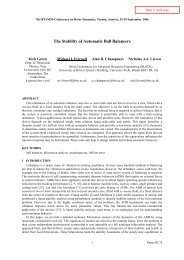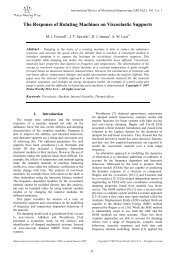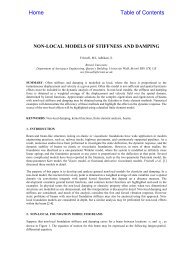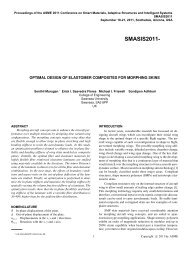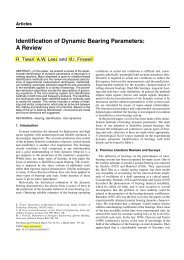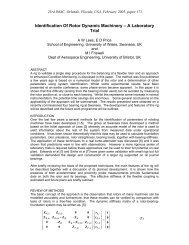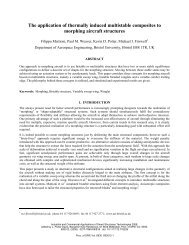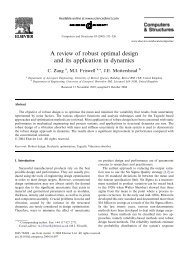Modelling Continuously Morphing Aircraft for ... - Michael I Friswell
Modelling Continuously Morphing Aircraft for ... - Michael I Friswell
Modelling Continuously Morphing Aircraft for ... - Michael I Friswell
Create successful ePaper yourself
Turn your PDF publications into a flip-book with our unique Google optimized e-Paper software.
ecause the chosen set of polynomials allows the rigid modes of the plate. Moreover, assuming a set of<br />
complete polynomials will allow (see Sec. II.F) the easy implementation of multiple plate capability of plates<br />
with arbitrary orientation in space, as <strong>for</strong> each body in the system is represented by the same set of shape<br />
functions.<br />
The choice of shape functions previously made yields a total number of 66 dof. If the transverse shears are<br />
neglected and a CPT is assumed then the number of dof decreases to 41. The main geometrical parameters<br />
of the wing box are reported in Tab. 1; the wing box has rectangular section (see Fig. 3) with structural<br />
chord b which is half of the aerodynamic chord c while the depth is set to h = .1c. The wing has a front<br />
and a rear spar and a web of three ribs equally spaced along the wing of length L. Each spar and rib carries<br />
two caps having area A. Skin, spars and ribs are assumed to have the same thickness t which is constant<br />
all over the wing. Two cases of leading edge sweep angle are considered <strong>for</strong> the current validation, namely<br />
E 70 GPa<br />
ν 0.35 -<br />
ρ 2700 Kg/m 3<br />
L 0.8 m<br />
c 0.3 m<br />
t 4 10 −3 m<br />
A cap 10 −4 m 2<br />
N spar 2 -<br />
N rib 3 -<br />
Figure 3: Wing-box scheme.<br />
Table 1: Material and geometrical properties of the<br />
wing box.<br />
Λ LE = 0 ◦ and Λ LE = 30 ◦ . Finally, expressions <strong>for</strong> the mass and the stiffness matrices can determined as<br />
M = M(ρ; b, h, L, Λ LE , t, A cap , N spar , N rib ) (36)<br />
K = K(E, ν; b, h, L, Λ LE , t, A cap , N spar , N rib ) (37)<br />
In order to validate the structural tool, an accurate model of the wing box has been built and analysed using<br />
NASTRAN. Skin, ribs and spars are modelled by CQUAD4 elements while the caps are modelled by CROD<br />
elements, leading to a total number of 6600 dof.<br />
II.E.1. Static validation<br />
In terms of static analysis only the stiffness matrix is involved, and two load cases are considered<br />
1. a concentrated vertical <strong>for</strong>ce F z = 1 N<br />
2. a concentrated torque M y = 1 Nm about the y axis<br />
both applied at the middle chord of the tip section. It has to be noted that a single concentrated load<br />
represents the most critical situation <strong>for</strong> the equivalent plate model which is best suited <strong>for</strong> distributed<br />
loads. the reason is because the method tends to smear local effects over the wing area, and so localized<br />
load effects are averaged over the whole domain. These two cases have been selected in order to investigate<br />
the limits of the method.<br />
The results <strong>for</strong> the first case are shown in Fig. 4. Specifically, the vertical displacements w of the<br />
middle chord of the tip section are shown, both <strong>for</strong> an unswept wing and a 30 ◦ swept wing. For each<br />
case displacements obtained from the CPT, FSDP and NASTRAN are compared. The rotations of the tip<br />
section, the consequence of an applied unitary torque, are shown in Fig. 5. Finally, the relative errors with<br />
respect to the NASTRAN results are shown in Tab. 2. The FSDP shows the maximum relative error of<br />
8.4% <strong>for</strong> the tip vertical displacement, corresponding to the 30 ◦ swept wing with applied vertical <strong>for</strong>ce at<br />
the wing tip. In all the other cases the error is under 4%. The CPT exibits a maximum error of 26.5% <strong>for</strong><br />
the rotation corresponding to the 30 ◦ swept wing with applied torque at the wing tip. Note that the FSDP<br />
theory gives results which are more accurate than the CPT. Moreover, the CPT overestimates the stiffness<br />
matrix leading to a wing whose overall behavior is stiffer than the FE model.<br />
8 of 23<br />
American Institute of Aeronautics and Astronautics




